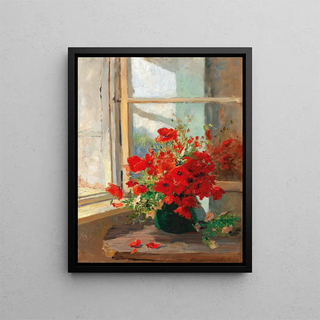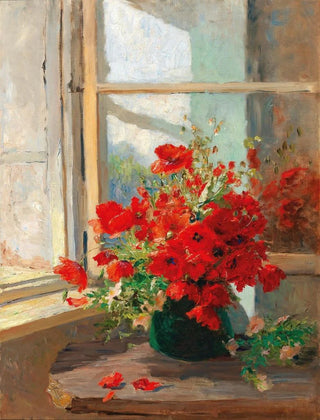Art print | A bouquet of poppies near the window - Olga Wisinger-Florian


View from behind

Frame (optional)
In the vibrant world of art, some works stand out for their ability to evoke deep emotions and capture fleeting moments of beauty. "A bouquet of poppies near the window" by Olga Wisinger-Florian is one of these creations. This piece, which perfectly fits within the Impressionist movement, invites us to contemplate the delicacy of the flowers while immersing us in an intimate atmosphere. Through vibrant colors and play of light, the artist succeeds in transforming a simple bouquet into a true ode to nature. This painting, both simple and complex, transports us to a universe where each petal seems to tell a story.
Style and uniqueness of the work
Olga Wisinger-Florian's work is characterized by a unique approach to color and light. In "A bouquet of poppies near the window," she uses vibrant shades of red and green that dance across the canvas, creating a captivating visual harmony. The subtly orchestrated play of light brings the poppies to life, making them almost vibrate under the effect of a gentle breath. The composition, though simple in its subject, reveals an emotional depth that invites the viewer to pause and contemplate. Every brushstroke seems to be a caress, an invitation to appreciate the fleeting beauty of nature. The artist manages to capture the very essence of these flowers, their fragility, but also their strength, offering a reflection on the passage of time and the ephemeral beauty of life.
The artist and her influence
Olga Wisinger-Florian, an emblematic figure of Austrian Impressionism, managed to establish herself through her distinctive style and artistic sensitivity. Born in 1844, she was influenced by the great masters of her time, while developing a personal voice that is uniquely her own. Her work is distinguished by a particular attention to the details of nature, a passion for color, and an ability to translate complex emotions through everyday scenes. Wisinger-Florian also played a crucial role in the emancipation of women artists.

Matte finish

View from behind

Frame (optional)
In the vibrant world of art, some works stand out for their ability to evoke deep emotions and capture fleeting moments of beauty. "A bouquet of poppies near the window" by Olga Wisinger-Florian is one of these creations. This piece, which perfectly fits within the Impressionist movement, invites us to contemplate the delicacy of the flowers while immersing us in an intimate atmosphere. Through vibrant colors and play of light, the artist succeeds in transforming a simple bouquet into a true ode to nature. This painting, both simple and complex, transports us to a universe where each petal seems to tell a story.
Style and uniqueness of the work
Olga Wisinger-Florian's work is characterized by a unique approach to color and light. In "A bouquet of poppies near the window," she uses vibrant shades of red and green that dance across the canvas, creating a captivating visual harmony. The subtly orchestrated play of light brings the poppies to life, making them almost vibrate under the effect of a gentle breath. The composition, though simple in its subject, reveals an emotional depth that invites the viewer to pause and contemplate. Every brushstroke seems to be a caress, an invitation to appreciate the fleeting beauty of nature. The artist manages to capture the very essence of these flowers, their fragility, but also their strength, offering a reflection on the passage of time and the ephemeral beauty of life.
The artist and her influence
Olga Wisinger-Florian, an emblematic figure of Austrian Impressionism, managed to establish herself through her distinctive style and artistic sensitivity. Born in 1844, she was influenced by the great masters of her time, while developing a personal voice that is uniquely her own. Her work is distinguished by a particular attention to the details of nature, a passion for color, and an ability to translate complex emotions through everyday scenes. Wisinger-Florian also played a crucial role in the emancipation of women artists.






